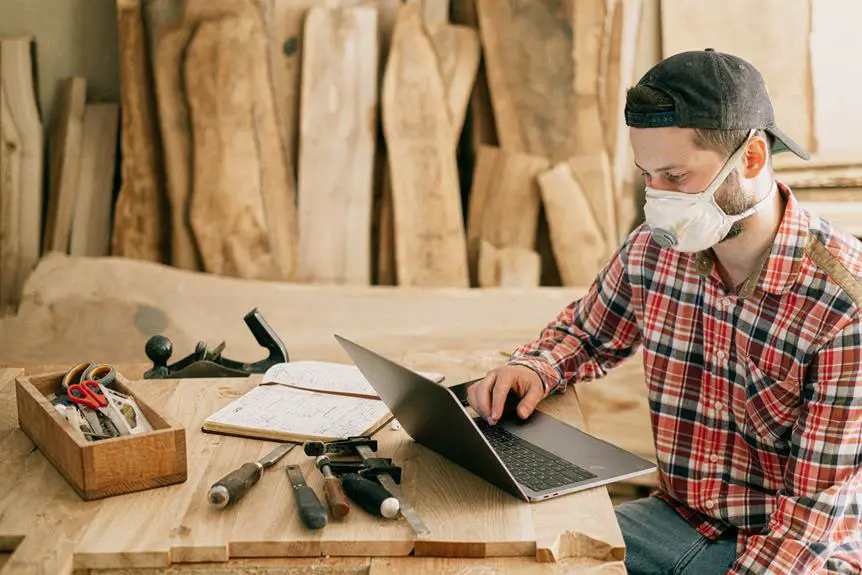Looking for a DIY VESA mount for your home office? You've probably heard that a VESA mount can maximize your monitor space and improve your ergonomic setup. But is it really worth the effort of making one yourself?
Absolutely. With the right tools and a little know-how, you can create a custom VESA mount that perfectly suits your workspace. Not only will you save money, but you'll also gain the satisfaction of mastering a practical DIY project.
So, let's dive into the steps and tips for creating a sturdy and adjustable VESA mount that will elevate your home office setup.
Key Takeaways
- Understanding VESA mount compatibility is crucial for a successful setup.
- Measure the distance between the mounting holes to determine compatibility.
- Use a stud finder to securely attach the mount to a stud or solid wall using appropriate screws and tools.
- Customizing your VESA mount allows for personalized positioning and cable management solutions.
Understanding VESA Mounting
If you're considering a DIY VESA mount for your home office, understanding VESA mounting is crucial for a successful setup.
VESA mount compatibility is essential to ensure that your monitor or TV is compatible with the VESA mount you intend to use. The VESA pattern, which consists of the horizontal and vertical distances between the four mounting holes on the back of your display, determines compatibility.
To determine your monitor's VESA compatibility, simply measure the distance between the mounting holes both horizontally and vertically. Once you have this information, you can ensure that the VESA mount you choose supports your display.
When it comes to VESA mount installation techniques, it's important to follow the instructions provided with your specific VESA mount. However, a general guideline is to ensure that the mount is securely attached to a stud or a solid wall to support the weight of your display. Additionally, make sure to use the appropriate screws and tools for installation to prevent any mishaps.
Understanding VESA mounting, including compatibility and installation techniques, is fundamental for a successful DIY VESA mount setup in your home office.
Tools and Materials Needed
To set up your DIY VESA mount, you'll need specific tools and materials for a secure and successful installation. Here are the essential items you'll need:
- Stud Finder: A stud finder is crucial for locating the studs in your wall, which are necessary for securely mounting the VESA arm. This tool ensures that your VESA mount is firmly anchored and can support the weight of your monitor.
- Drill and Drill Bits: You'll need a drill for creating pilot holes and installing the mounting screws. Ensure you have the appropriate drill bits for your wall type, whether it's drywall, plaster, or concrete, to achieve a secure attachment.
- Level: A level is essential for ensuring that your VESA mount is straight and properly aligned. This is crucial for achieving a professional and aesthetically pleasing home office setup.
Gathering these tools and materials will prepare you for a successful DIY VESA mount installation, providing a sturdy and ergonomic solution for your home office.
Step-by-Step Mounting Instructions
Once you have gathered the necessary tools and materials, begin by using the stud finder to locate a secure position for mounting the VESA arm. Once you've found a suitable location, hold the VESA mount against the wall and mark the positions for drilling. Use a drill to create pilot holes for the screws, making sure they align with the VESA mount holes. Secure the mount to the wall using the appropriate screws and wall anchors, ensuring it's firmly attached.
Next, attach the VESA plate to the back of your monitor or TV using the provided hardware. Carefully lift and hook the VESA arm onto the mounted plate, ensuring a secure connection. Adjust the arm to your desired height and angle, then tighten the screws to lock it in place.
For troubleshooting, ensure that all screws and connections are securely tightened. If the mount isn't holding the weight properly, double-check the installation and consider consulting the manufacturer's guidelines.
When it comes to cable management, use cable clips or ties to keep the cables organized and out of the way. This not only improves the aesthetics but also reduces the risk of tangling or damage.
Customizing Your VESA Mount
When customizing your VESA mount, ensure the arm is positioned both within and beyond your preferred viewing range for optimal ergonomics. This allows for comfortable viewing and reduces strain on your neck and eyes.
Here are some customization ideas and creative alternatives to consider:
- Adjustable Arm Length: Opt for a VESA mount with an adjustable arm length to cater to different desk depths. This allows you to position your monitor at the perfect distance for your comfort and viewing needs.
- Tilt and Swivel Features: Look for a VESA mount with tilt and swivel capabilities, offering you the flexibility to adjust the monitor's angle and orientation. This is especially beneficial if you frequently switch between tasks that require different screen orientations.
- Cable Management: Incorporate cable management solutions into your VESA mount setup. This can help keep your workspace organized and free from tangled wires, enhancing the overall aesthetics of your home office while improving functionality.
Tips for Maintaining Your VESA Mount
Regularly inspect and tighten the screws on your VESA mount to ensure stability and prevent potential damage. Use a screwdriver to check the tightness of all screws, especially those securing the monitor to the mount and the mount to the desk or wall. Loose screws can lead to instability and pose a risk to your expensive monitor. Additionally, ensure that the mount is securely attached to the wall or desk by checking the mounting brackets and hardware.
When it comes to cleaning and maintenance, use a soft, dry cloth to remove dust and dirt from the VESA mount regularly. Avoid using liquid cleaners directly on the mount as they may seep into the internal mechanisms and cause damage. If you encounter common issues such as monitor drooping or the mount not holding the desired position, refer to the manufacturer's troubleshooting guide. Often, these issues can be resolved by adjusting the tension screws or repositioning the mount.
Frequently Asked Questions
Can a DIY VESA Mount Be Used to Mount a TV as Well as a Monitor?
Yes, a DIY VESA mount can be used to mount both a TV and a monitor. Make sure to check the VESA mount compatibility for your specific TV and monitor to ensure they can be securely and safely mounted.
Is It Possible to Paint or Decorate the DIY VESA Mount to Match the Home Office Decor?
Yes, you can definitely customize your DIY VESA mount with various painting options and decorative finishes to match your home office decor. Consider using spray paint, vinyl wraps, or decorative contact paper for a personalized touch.
Can the DIY VESA Mount Be Easily Removed and Re-Installed in a Different Location?
Yes, the DIY VESA Mount can be easily removed and re-installed in a different location. The installation process is straightforward, and it offers stability and durability. You'll appreciate the convenience and flexibility it provides.
Are There Any Weight Limitations for the Monitor or TV That Can Be Mounted Using a DIY VESA Mount?
There are weight limitations for the monitor or TV you can mount using a DIY VESA mount. Make sure to check the weight capacity of your mount before installation. Also, consider adjustable angles for optimal TV mounting.
Can the DIY VESA Mount Be Adjusted for Different Viewing Angles Once It's Installed?
Once installed, the DIY VESA mount can be adjusted for different viewing angles. It's compatible with various monitor sizes and offers customization options. It has weight capacity limitations and can be portable and reusable.



